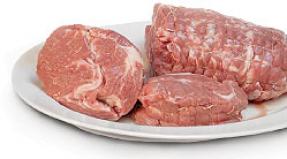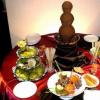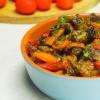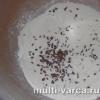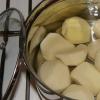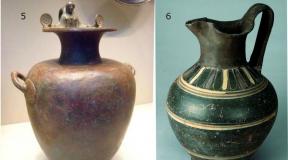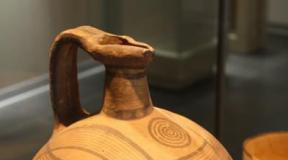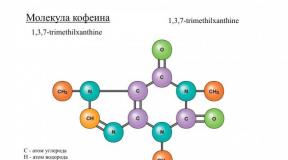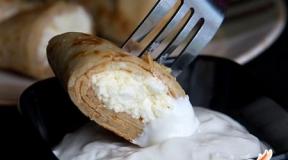Cold appetizer from "centenary eggs" with Duojiao (recipe with photo). "Centenary eggs" - a terrible muck or an unsurpassed delicacy
Centenary eggs, also known as millennials, are Chinese canned food product, which in our time is a delicacy. These are duck, chicken or quail eggs stored wrapped in a mixture of clay, salt, ash, quicklime, and rice hulls for a long time (from several weeks to several months).
How do they look?
Due to this, the yolk becomes dark green or gray in color and has a creamy consistency and strong aroma, due to the presence of hydrogen sulfide and ammonia, and the protein becomes dark brown and looks like a translucent jelly with salty taste... The transforming agent in a century-old egg is alkaline salt, which gradually raises the egg's pH to about 9-12. This chemical process breaks down some of the complex, tasteless proteins and fats, and as a result of this process, many smaller aromatic compounds are created.
Some centenary eggs have patterns near the surface. egg white which look like the branches of a pine tree, and this gives rise to one of its Chinese names - "pine egg".

Story
The way this product was created probably stemmed from the need to preserve eggs during periods of abundance by covering them with alkaline clay. This is similar to conservation practices in some Western cultures. The clay hardens around the egg and leads to canning instead of spoilage.
According to some researchers, Chinese centenary eggs have more than five centuries of history behind them. Their discovery is said to have taken place about 600 years ago in the Hunan province during the reign of the Ming dynasty.
Legend has it that one of the homeowners discovered duck eggs in a shallow pool of slaked lime that had been used for mortar during the construction of his home two months earlier. After tasting these eggs, he decided to make another batch, this time with the addition of salt to improve the taste, and this subsequently led to the creation of the recipe for this dish.
Oddly enough, it was not only in antiquity that a hundred-year-old egg was widespread. Reviews of gourmets indicate that this product is in great demand today, and many tourists, once in China, try to try this particular delicacy.

Methods
The traditional method of producing century-old eggs is the aforementioned primitive process developed and refined. Instead of using clay alone, a mixture of wood ash, calcium oxide and salt is added to the preservative mixture, thereby increasing the pH and sodium content. The addition of calcium oxide and wood ash to the mixture reduces the risk of spoilage and also increases the speed of the fermentation process.
The recipe for creating a 100-year-old egg begins by pouring one and a half liters of tea into boiling water. Add to it 1.5 kg of calcium oxide, 3 kg sea salt and 3 kg of burnt oak ash, which are mixed until thick paste... Then put on gloves (to chemical substances do not get on the skin) and each egg is individually covered with this mass by hand, after which it is rolled in rice husks.
The blanks are then placed in cloth-covered cans or tightly woven baskets. The mixture dries slowly and turns into a crust over several months, after which the eggs are ready to eat.

Modern technique
Though traditional method still widely practiced, modern advances in chemistry have allowed many simplifications to be made in the recipe. For example, in order to achieve the same effect as before, you can soak raw eggs in solution table salt, calcium hydroxide and sodium carbonate for 10 days, followed by aging for several weeks, wrapped in plastic wrap.
This is due to the fact that the reaction required to obtain a fermented product is carried out by introducing hydroxide and sodium ions into the egg, regardless of the method used.
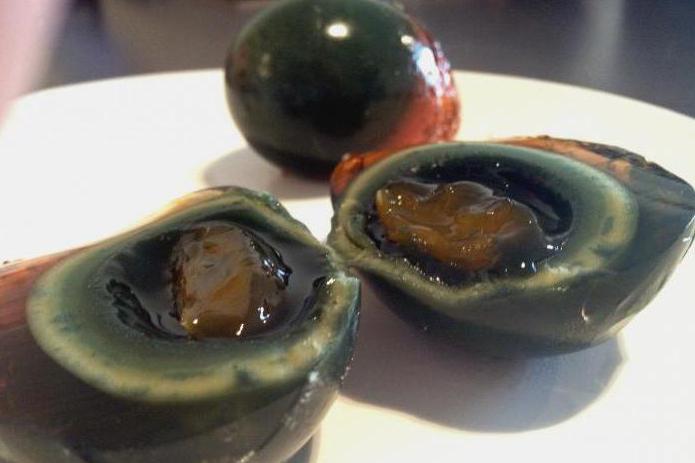
Potential danger
The highly toxic lead oxide accelerates the reaction to form this product, prompting some unscrupulous manufacturers to use it. Zinc oxide is currently the recommended alternative, although not the safest.
Although zinc is essential for the body, excessive intake of it can lead to a copper deficiency, so too much zinc can be harmful.
How is it used?
What does a century-old egg taste like? Those who have tasted this delicacy claim that it has a specific tangy flavor. The centenary egg can be eaten without further preparation - on its own or as a side dish. The following appetizer is popular: the cut product is wrapped in pieces of pickled ginger and served on a stick. It is also widely known to combine a fermented egg with chilled tofu.
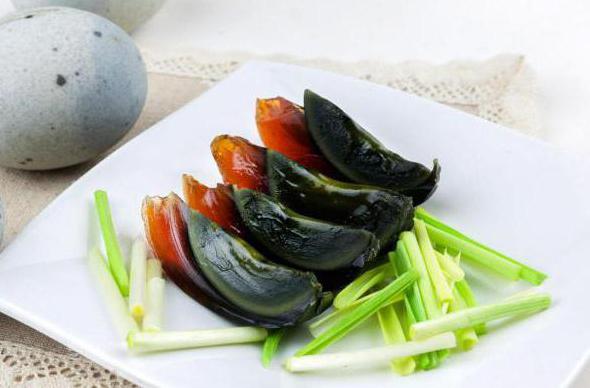
In Taiwan, it is customary to eat centenary eggs by cutting them and placing cold tofu with katsuobushi, soy sauce and sesame oil... Another variation of this recipe, common in North China, is to chop the eggs and mix with chunks of soft tofu, add a small amount of chopped young ginger and green onions, then pour the mixture over the top. soy sauce and sesame oil.
This product is also used in a dish called "Old and fresh eggs”Where shredded fermented billets are mixed with chopped fresh omelet. They can also be cut into pieces and mixed with vegetables, which is most common in Taiwanese cuisine. Some Chinese housewives cut their century-old eggs for small pieces and boiled with rice porridge.
In restaurants Chinese food such a dish as dim sum is widespread. Boiled rice, Lean pork and fermented egg are the main ingredients of this dish. Peeled centenary eggs are cut into four or eight pieces and boiled with seasoned marinated pork slices until both are cooked into porridge, after which they are mixed with rice.
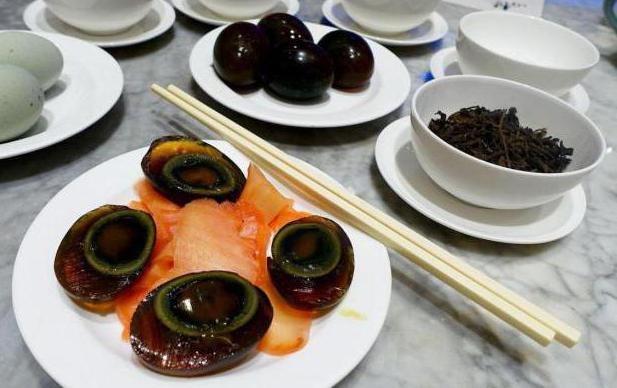
Fried dough sticks, known as etao, are commonly eaten with this fermented product.
At special events such as wedding banquets or birthday parties, served in China special dish... It consists of fried on open fire pork, pickled leeks, spicy carrots, daikon radish, and quartered 100-year-old eggs. This dish is called lahng-poon in Cantonese, which means "cold dish".
The urine use myth
According to a common misconception, centenary eggs are sometimes prepared by dipping in horse urine. The myth could have arisen from the urinary odor of ammonia and other amines caused by a chemical reaction used for fermentation. However, this myth is unfounded, as horse urine has a pH between 7.5 and 7.9 and is therefore not suitable for this process.
How to cook it yourself?
There is absolutely no need to travel to China or another Asian country to taste this delicacy. You can try to make them yourself by choosing modern method to achieve a positive result. You will need a pickling solution using salt and lye and then wrapping the eggs in plastic clay. In about a month, you will receive original product- century-old eggs, photos of which are presented in this article.
What you need:
- 100% alkali / caustic soda (NaOH - sodium hydroxide);
- salt (NaCl - sodium chloride);
- chicken egg (or duck, or quail);
- plastic film;
- clay (polymer for crafts);
- glass jar with a lid.
Centenary Egg: Cooking Recipe
Chemically, alkali is corrosive, not poison. Therefore, its danger is that it can cause severe burns by contact with skin or inhalation. Use gloves and a respirator to avoid this.
Use pure 100% alkali (sodium hydroxide). Prepare necessary components in the following quantities:
- 1 liter of water;
- 42 g sodium hydroxide (NaOH, alkali);
- 72 g sodium chloride (NaCl, salt).
At low temperature, completely dissolve salt and alkali in water. Bring the solution to a boil and let it cool before using.
Place raw eggs in glass jar and pour the cooled pickling solution over them. Make sure they are all completely submerged in water.
Label the jar and store it in a safe place so no one accidentally opens it. Leave the eggs at 15-20 ° C for about 10 days. Watch them so that they do not float in the solution.
After this time, carefully pour the solution and select the eggs, rinse them with water, then dry them with a towel. The shells should remain firm, but slightly discolored.
Then wrap the eggs in several layers of clear plastic wrap and cover them with a thick layer of polymer clay. This prevents oxygen from reaching them during fermentation.
Be careful when pasting with clay - you should not damage the eggs. After wrapping, place the eggs in any container with a lid and let sit for 2 weeks. During this time, you should have finished 100-year-old eggs. The photo recipe contained in this article assumes full readiness product within the specified period.
After that, gently peel off the clay shell and unfold the plastic wrap, then press lightly on the egg to break the shell.
You can make sure that the egg white has become jelly-like and has a translucent amber color and the yolks are dark green and have a texture similar to a hard boiled egg.
Recently, the American broadcaster CNN, with the help of its so-called citizen correspondents, compiled a list of the most disgusting dishes in the world. The main terrible delicacy was called "centenary eggs" - a traditional dish Chinese food. A few days later, the Chinese themselves reacted to CNN's insolence - they took offense at the TV company, accused its employees of ignorance and demanded an apology.
"Centenary egg" or as it is also called " millennium egg» - chinese delicacy... This is a black, artificially aged egg that never goes bad.
Let's find out how it turns out this way ...
The eggs are covered with rice husks, clay, salt and ash. The eggshell protects them from these elements and microbes for several months while they are buried. Eggs have a different consistency than their fresh counterparts. The protein turns into a creamy brown jelly, and the yolk turns into a black powdery substance. Consumption of "centenary eggs" is believed to heal high blood pressure and relieves bad appetite. Historically they are made from duck eggs, but goose, chicken, turkey and quail eggs can be used as an alternative.

Modern way the preparation may differ from the traditional one. New methods include soaking the eggs in a very strong alkaline solution. Sometimes zinc or lead oxide is added to soften the yolk of "centenary eggs". The main catalyst for the physicochemical changes that take place in buried eggs is sodium hydroxide, which is formed in the paste or solution that covers the eggs. This alkali causes changes in the color and consistency of the egg components.

Centenary eggs have a scent that resembles some cleaning products. Hydrogen sulphide and ammonia, which are produced during the fermentation process, give the eggs their distinctive signature imprint. Eggs can be used as a side dish or served separately. Most often they are eaten with tofu or with rice broth and pork. Since some cooking methods involve the use of lead oxide, there is a chance that it will get into the food. You don't have to visit China to taste the "centenary eggs". In most Asian grocery stores outside the region, you can find this delicacy.
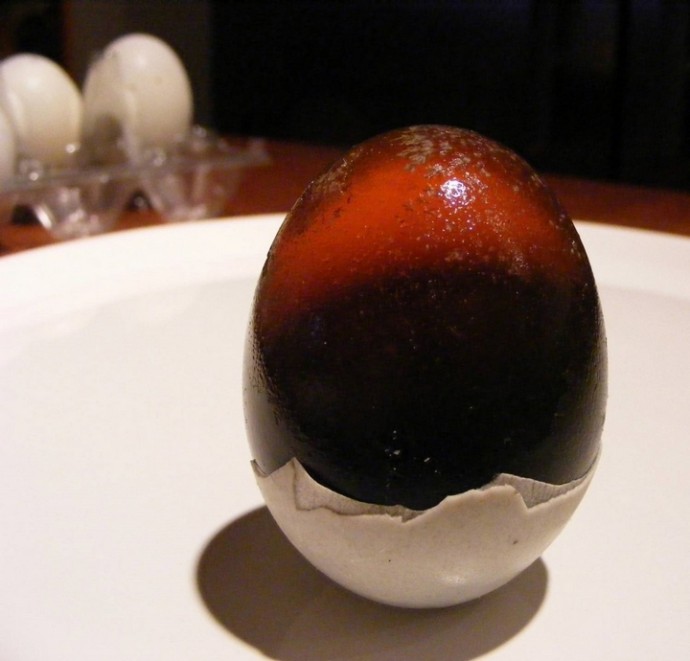
Traditions national cuisines sometimes they are very ambiguous: somewhere it is considered commonplace to eat fried guinea pig for lunch, somewhere they prefer soup made from duck blood, well, in some places, eggs of unsightly color are served to the table, which have lain in the ground for a couple of months. And nothing - people eat. True, for some who are used to, for example, eating cheeseburgers with cola, this approach to the diet seems, to put it mildly, strange.
This is understandable - gastronomic traditions have been formed over the centuries in a certain territory, and travel far beyond its borders is often dangerous and unpleasant. Even today, for example, not everyone can cope with the natural disgust that acts as a kind of accident insurance in case of acquaintance with exotic food - it will not be very polite on the part of a beginner if he suddenly vomits at the hospitable table of foreign friends.

To try the "century-old eggs", which in appearance resemble some kind of alien jelly, it is not at all necessary to go to a remote Chinese village. You can just go to the supermarket and buy a package of these ugly, but obviously beloved by the Chinese eggs. Several companies are engaged in the production of such products, but the largest of them is currently Shendan, whose employees apparently read CNN Go from time to time.
Otherwise, explaining what happened literally a week after the publication of the list of disgusting food is difficult. Here's what happened: On July 6, the chairman of the Shendan board of directors and three thousand of his subordinates filed a complaint with CNN demanding an apology for awarding the "hundred-year-old eggs" the title of the most disgusting food in the world.

Among other things, the document says that the employees of the American television company made completely unfounded and unscientific conclusions about taste famous chinese appetizer... And this circumstance indicates that the authors of the note about national dishes showed disrespect for foreign culture, and also demonstrated their ignorance and arrogance.
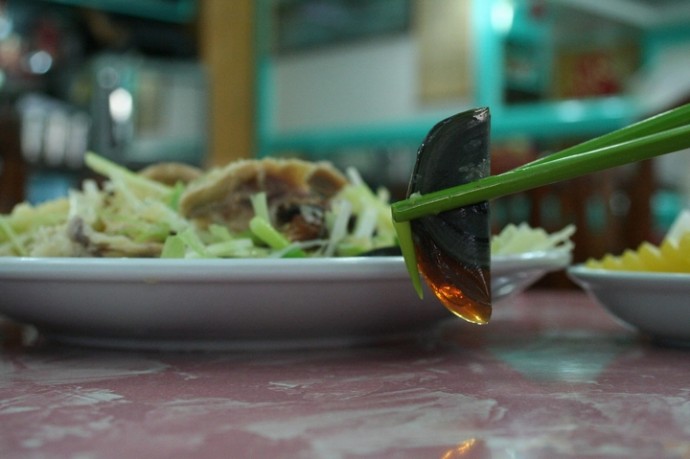
On the one hand, comrades from the Shendan egg company can be understood - who will like it if your favorite food is called utterly nasty, which cannot be eaten without tears in your eyes and the urge to vomit. But on the other hand, if you look at the situation a little differently, you can come to simple and obvious conclusions.

The private opinion of a person who bought for the sake of a culinary experiment cannot be called ignorant and arrogant. unusual food... Even if, before taking a sample from “centenary eggs”, the author of a note about them armed himself to the teeth with all sorts of theoretical calculations about the history of the origin of the recipe and the benefits of the product, he would hardly be able to oppose this knowledge of the reaction of his taste buds.

After all, CNN's civilian correspondent was honest about the experience, and the vibrant emotions of the typical Westerner give the taste of an Eastern product more insight than traditional, healthy dish with a rich history ". After all, readers are waiting for the assessment, and not for what they themselves are able to read in the culinary encyclopedia.

In a word, before starting to write an angry complaint, the Chinese company should not forget that there are indeed many rather peculiar and strange dishes in the world and their popularity directly depends on the culinary preferences of not only different nationalities in general, but also individual people in particular (so moreover, some of the inhabitants of China speak of the simplest and most familiar cheese to most people in the West in about the same way as the author of a short article in CNN Go - about "hundred-year-old eggs").
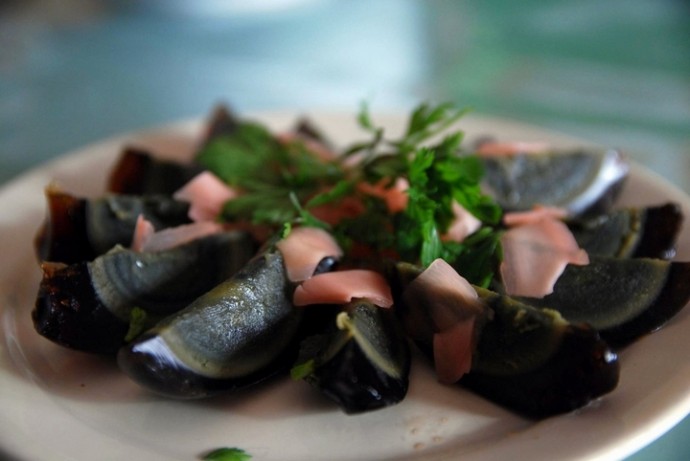
It is possible that among the readers of this text there is one fearless fan of "hundred-year-old eggs" who subscribes them for big money directly from China and at the same time cannot stand fried potatoes, calling it nothing less than the most disgusting food in the world. So a large producer of egg products could not have paid any attention to someone's "fu".

This was done (at least for now) by other manufacturers of those unusual dishes that have been on CNN's list. In particular, Filipino woodworm larvae in a sauce of vinegar, salt and lime are next to the “centenary eggs” in the ranking. Until it occurred to the Filipinos to write a letter to CNN with a complaint with an argument in the style of "I don't count your stupid hot dog as food."

There were no angry letters from those who specialize in the production of fermented soy chips (Indonesia), products from dog meat and offal ( South Korea), fried spiders (Cambodia), fried cicadas (Thailand) and fried frogs (Philippines again). Because, probably, all these people have no time - they are busy with their own affairs, and crazy foreigners driving around different countries and making big eyes at the sight of locusts in sweet sauce, they are not decree.

And rightly so. Conflicts in which taste is the key are doomed to failure in advance. In the end, such clashes of opinion are about the same as a dispute about the beauty of a particular shade of color. All the same, everyone will remain unconvinced. And instead of quarreling over some nonsense, it's better to make yourself huge sandwich with delicious cheese, or no less tasty "century-old eggs" - that's who you like.

Europeans often call these eggs "rotten", and the Chinese, on the contrary, "imperial". Why is there such a difference in perception? As you know, "a billion Chinese cannot be wrong" ...
". And I remembered the recipes for culinary delicacies of the Celestial Empire. I rushed to look for this precious little book and ... alas ... How I hate these transfers. I don't even remember how it was literally called and now I don't even know what to look for. But, thank God, there is an Internet But the book is still a pity.
But back to the eggs. So, in this book I once read a recipe for making special eggs a long time ago. For some reason it seemed to me that they were called marble and therefore I was very surprised at the recipe given on "Culinary Eden". Having rummaged in the internet, I was convinced that I was wrong, on the contrary.
The eggs, the recipe of which struck me so many years ago, were called completely differently! They have many names, I will give just a few: "Songhuadan" (松花蛋), "Imperial eggs", Chinese black (hundred-day, centenary, canned, pidan) eggs, among foreigners they are known as "Rotten Eggs".
In a direct translation from Chinese, "Songhua" means "pine flowers" ("tribute" - "eggs"), tk. after cleaning from the shell, in them, hardened and translucent, mesh patterns are visible, reminiscent of pine needles. The richer the pattern, the higher the quality of the eggs.

|
Ready canned eggs soft, smooth, at the same time elastic; the yolk becomes dark and gelatinous. Due to the sodium hydroxide and ammonia released by the eggs during cooking, Songhuadan may have a slight alkaline odor and a viscous taste. A small amount of a mixture of vinegar, ground ginger root and soy sauce will help neutralize these effects and improve the taste of the dish. (Information taken from the site: www.abirus.ru/map/ck5.htm)
Songhuadan (canned duck eggs)
A thick mass is prepared from the ash of mulberry trees, pea stalks, raw lime, baking soda, salt and tea leaves. With this mass, washed duck eggs are coated with a layer of 2-3 cm. Then the eggs are rolled in rice husks, placed in a vat, tightly covered with a lid and stored for 80-100 days. Tinned eggs can be stored for several years if the integrity of the coating and shell is not compromised. (Information taken from the site: www.kulina.ru/articles/national/chinese/sunhuadan) Or like this:
Sunhuadan - imperial eggs
Brush raw eggs with a mixture of earth, salt, lime and soy sauce and bury them in the ground. After 60 days, scoop up and make sure the yolk turns dark green and the white turns black and transparent. Now you can serve it to the table. For the Chinese, this dish is a delicacy, as for the French, blue cheese. In an amicable way, the eggs should be duck, but if there are no Chinese nearby, a slightly corrected recipe will not offend anyone. (Information taken from the site: www.mhealth.ru/halogramm/snack/141392/index.php?print=1)
Or like this:
Canned Eggs (Chinese Food)
Genuine decoration chinese table are canned eggs. Fresh duck and chicken eggs placed in an earthenware vat on wheat straw and covered with bamboo dust. Then a decoction is made from soda, tea, salt, pine needles, which is mixed with clay, ash and lime. Eggs are poured with chilled broth and kept warm for more than a month. These eggs are sometimes considered rotten by foreigners, but they are delicious. nutritious dish with blue-black protein - one of the delicacies of Chinese cuisine. (Information taken from the site: www.eda-server.ru/cook-book/salat/zakuski-h/st00716.htm)
These are the exotic eggs !!! I really love various delicacies, but I haven’t been to China yet and I haven’t had a chance to try anything like that. Has anyone tried it? Share your impressions!
The American broadcaster CNN, with the help of its so-called civilian correspondents, has compiled a list of the most disgusting dishes in the world. The main gruesome delicacy was called “centenary eggs,” a traditional Chinese dish. A few days later, the Chinese themselves reacted to CNN's insolence - they took offense at the TV company, accused its employees of ignorance and demanded an apology.
The traditions of national cuisines are sometimes very ambiguous: somewhere it is considered commonplace to eat a fried guinea pig for lunch, somewhere they prefer duck blood soup, and in some places they serve unsightly eggs that have lain in the ground for a couple of months. And nothing - people eat. True, for some who are used to, for example, eating cheeseburgers with cola, this approach to the diet seems, to put it mildly, strange.
This is understandable - gastronomic traditions have been formed over the centuries in a certain territory, and travel far beyond its borders is often dangerous and unpleasant. Even today, for example, not everyone can cope with the natural disgust that acts as a kind of accident insurance in case of acquaintance with exotic food - it will not be very polite on the part of a beginner if he suddenly vomits at the hospitable table of foreign friends.
Photo 2.

"Century egg" (CENTURY EGGS) or as it is also called "millennial egg" is a Chinese delicacy. This is a black, artificially aged egg that never goes bad.
The eggs are covered with rice husks, clay, salt and ash. The eggshell protects them from these elements and microbes for several months while they are buried. Eggs have a different consistency than their fresh counterparts. The protein turns into a creamy brown jelly, and the yolk turns into a black powdery substance.
Consuming "centenary eggs" is believed to cure high blood pressure and relieve poor appetite. Historically they are made from duck eggs, but goose, chicken, turkey and quail eggs can be used as alternatives.
Photo 3.
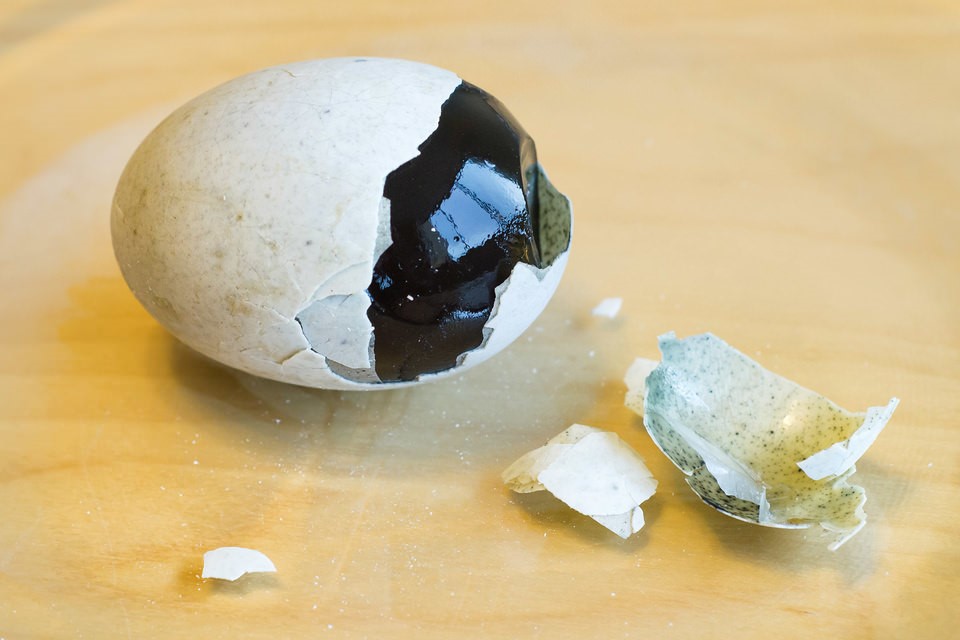
The modern way of cooking may differ from the traditional one. New methods involve soaking the eggs in a very strong alkaline solution. Sometimes zinc or lead oxide is added to soften the yolk of "centenary eggs". The main catalyst for the physicochemical changes that take place in buried eggs is sodium hydroxide, which is formed in the paste or solution that covers the eggs. This alkali causes changes in the color and consistency of the egg components.
Photo 4. 
Centenary eggs have a scent that resembles some cleaning products. Hydrogen sulphide and ammonia, which are produced during the fermentation process, give the eggs their distinctive signature imprint. Eggs can be used as a side dish or served separately.
Most often they are eaten with tofu or with rice water and pork. Since some cooking methods involve the use of lead oxide, there is a chance that it will get into the food. You don't have to visit China to taste the "centenary eggs". Most Asian grocery stores outside the region can find this delicacy.
Photo 5.
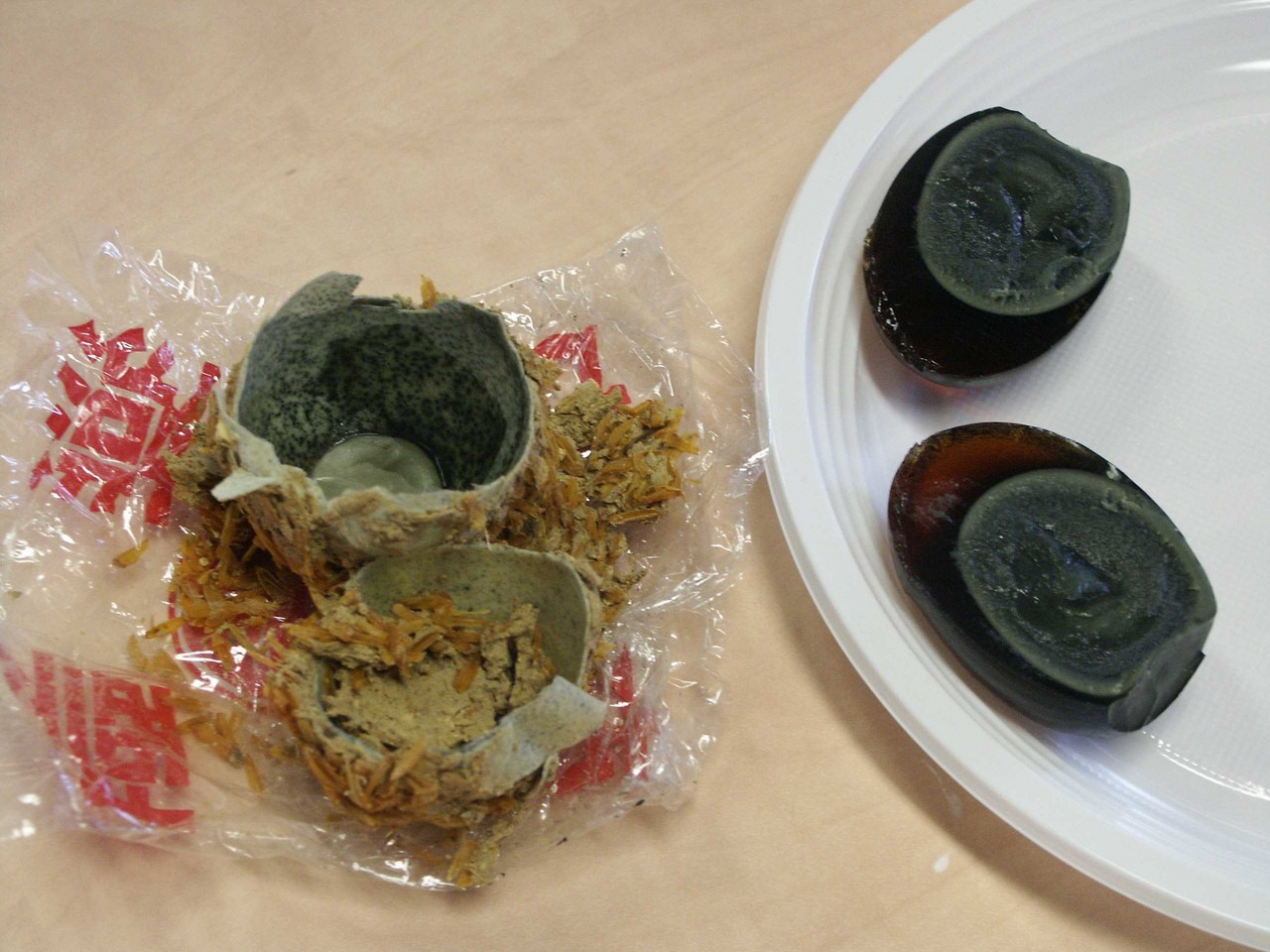

To try the "century-old eggs", which in appearance resemble some kind of alien jelly, it is not at all necessary to go to a remote Chinese village. You can just go to the supermarket and buy a package of these ugly, but obviously beloved by the Chinese eggs. Several companies are engaged in the production of such products, but the largest of them is currently Shendan, whose employees apparently read CNN Go from time to time.

Otherwise, explaining what happened literally a week after the publication of the list of disgusting food is difficult. Here's what happened: On July 6, the chairman of the Shendan board of directors and three thousand of his subordinates filed a complaint with CNN demanding an apology for awarding the "hundred-year-old eggs" the title of the most disgusting food in the world.
Among other things, the document says that the employees of the American television company made completely unfounded and unscientific conclusions about the taste of the famous Chinese snack. And this circumstance indicates that the authors of the note about national dishes showed disrespect for foreign culture, and also demonstrated their ignorance and arrogance.
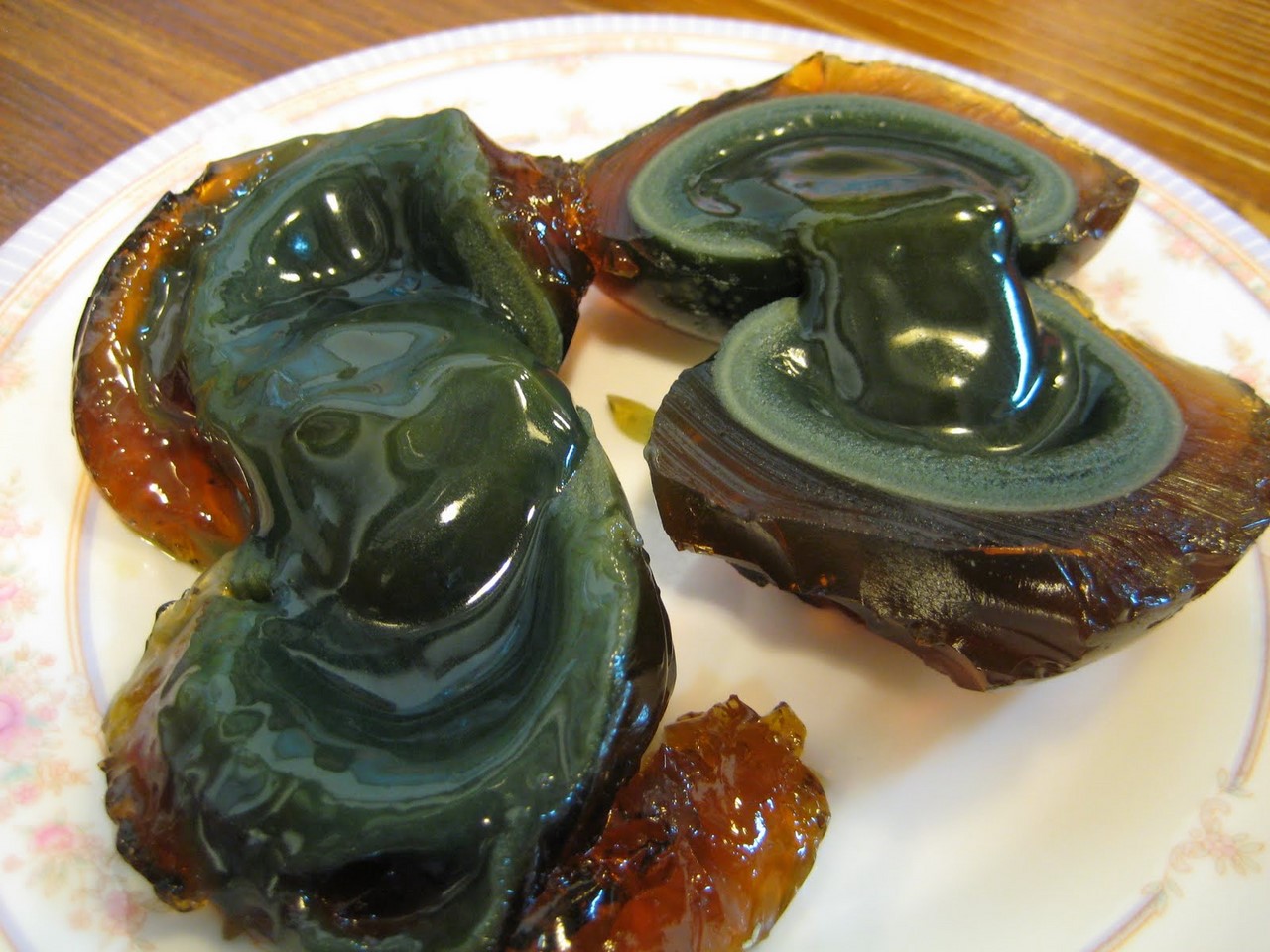
On the one hand, comrades from the Shendan egg company can be understood - who will like it if your favorite food is called utterly nasty, which cannot be eaten without tears in your eyes and the urge to vomit. But on the other hand, if you look at the situation a little differently, you can come to simple and obvious conclusions.
The private opinion of a person who has bought unusual food for the sake of a culinary experiment cannot be called ignorant and arrogant. Even if the author of a note about them had armed himself to the teeth with all sorts of theoretical calculations about the history of the origin of the recipe and the benefits of the product, before taking a sample from the "centenary eggs", he would hardly be able to oppose this knowledge of the reaction of his taste buds.

After all, CNN's civilian correspondent was honest in describing the sensation, and the vibrant emotions of the typical Westerner give more insight into the taste of an oriental product than the phrase “traditional, healthy dish with a rich history” does. After all, readers are waiting for the assessment, and not for what they themselves are able to read in the culinary encyclopedia.
In a word, before starting to write an angry complaint, the Chinese company should not forget that there are indeed many rather peculiar and strange dishes in the world and their popularity directly depends on the culinary preferences of not only different nationalities in general, but also individual people in particular (so moreover, some of the inhabitants of China speak of the simplest and most familiar cheese to most people in the West in about the same way as the author of a short article in CNN Go - about "hundred-year-old eggs").
It is possible that among the readers of this text there is one fearless fan of "hundred-year-old eggs" who subscribes them for big money directly from China and at the same time hates fried potatoes, calling it nothing but the most disgusting food in the world. So a large producer of egg products could not have paid any attention to someone's "fu".
This was done (at least for now) by other manufacturers of those unusual dishes that appeared in the CNN list. In particular, Filipino woodworm larvae in a sauce of vinegar, salt and lime are next to the “centenary eggs” in the ranking. Until it occurred to the Filipinos to write a letter to CNN with a complaint with an argument in the style of "I don't count your stupid hot dog as food."
Photo 10.

There were no angry letters from those who specialize in the production of fermented soy chips (Indonesia), products from dog meat and offal (South Korea), fried spiders (Cambodia), fried cicadas (Thailand) and fried frogs (Philippines again). Because, probably, all these people have no time - they are busy with their own business, and crazy foreigners traveling to different countries and making big eyes at the sight of locusts in sweet sauce, they are not a decree.
And rightly so. Conflicts in which taste is the key are doomed to failure in advance. In the end, such clashes of opinion are about the same as a dispute about the beauty of a particular shade of color. All the same, everyone will remain unconvinced. And instead of quarreling over some nonsense, it is better to make yourself a huge sandwich with delicious cheese, well, or no less tasty "hundred-year-old eggs" - that's who you like.

Europeans often call these eggs "rotten", and the Chinese, on the contrary, "imperial". Why is there such a difference in perception? As you know, "a billion Chinese cannot be wrong" ...

Photo 13.
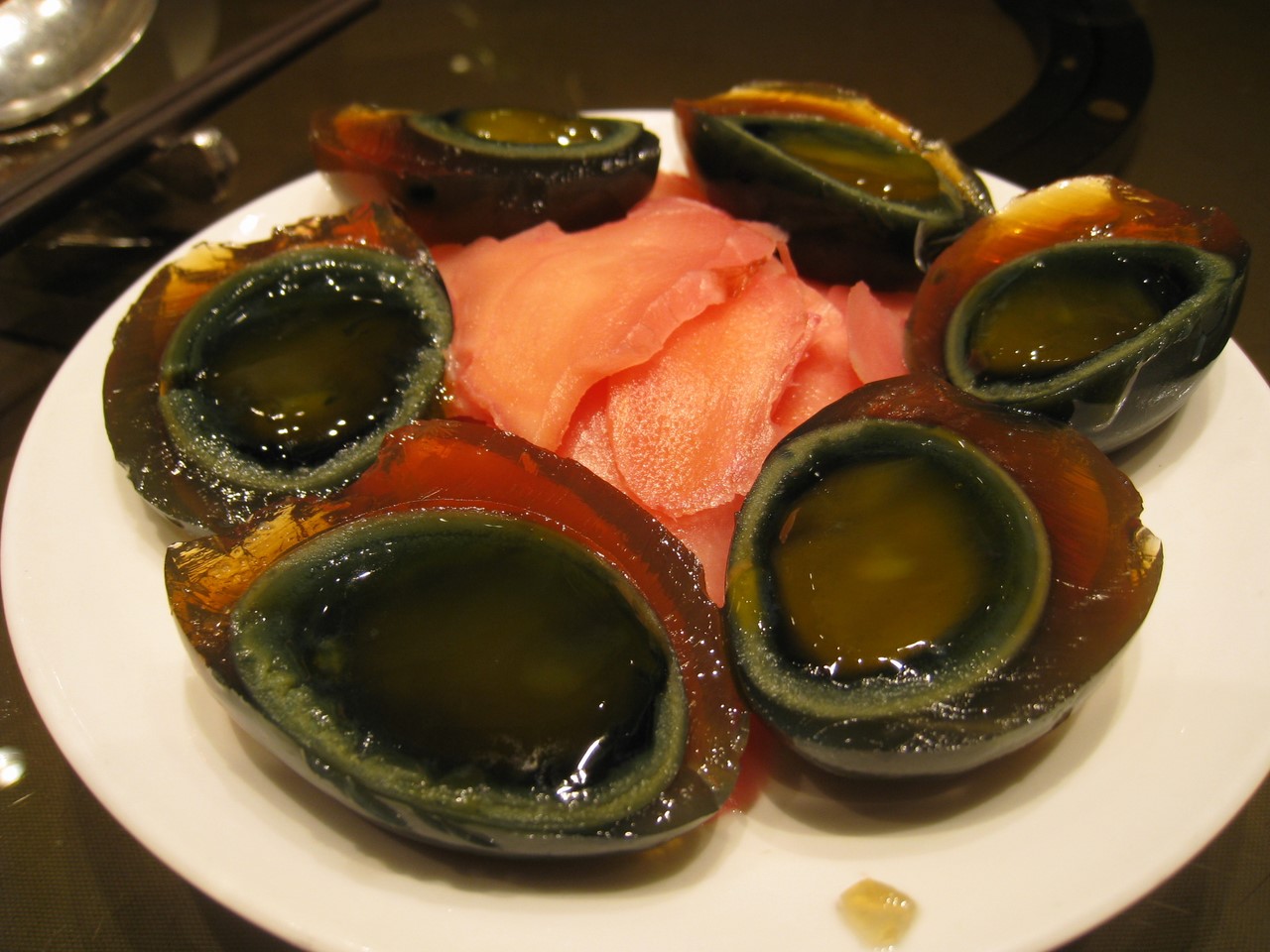
Photo 14.

Photo 15.
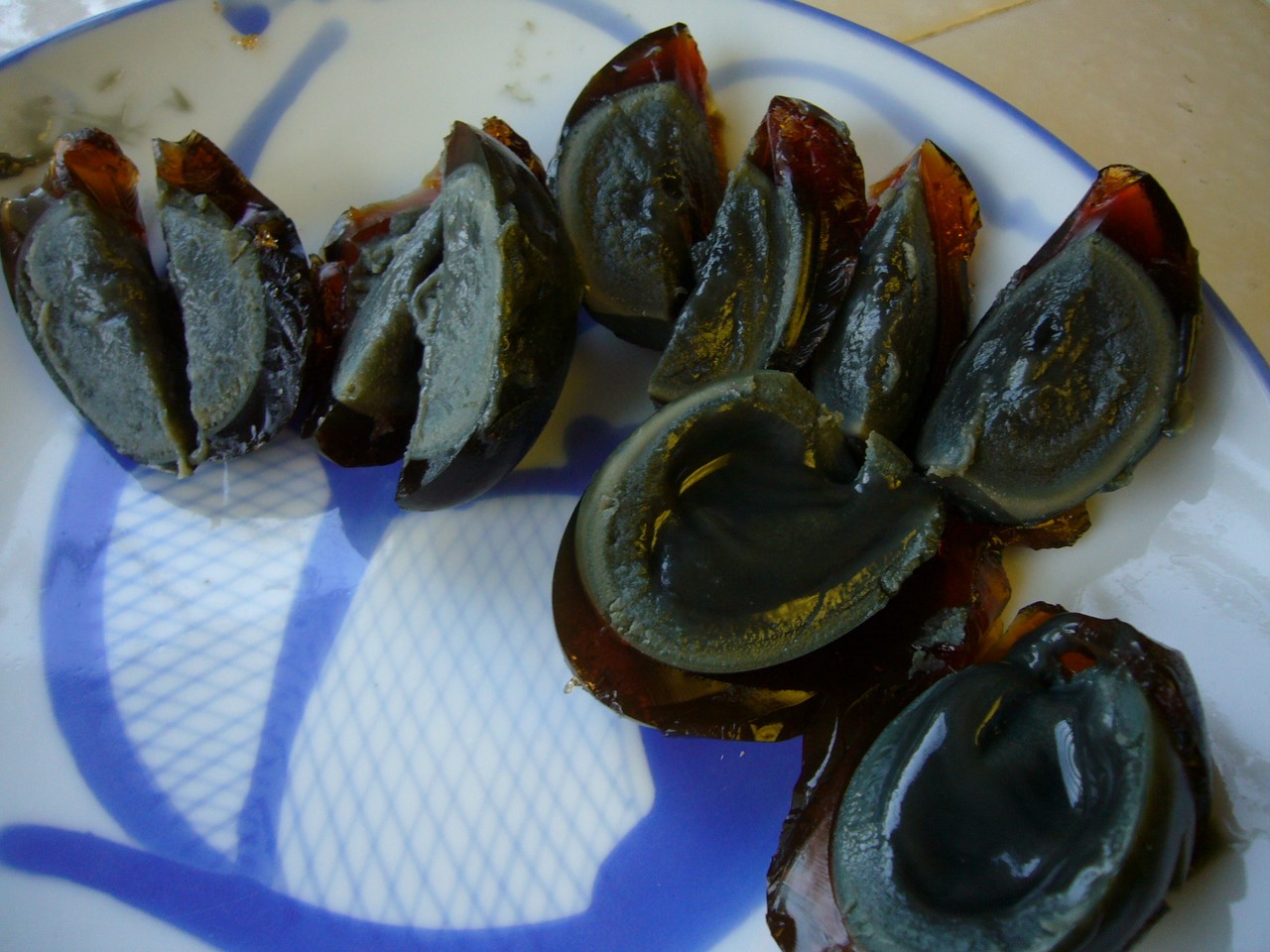

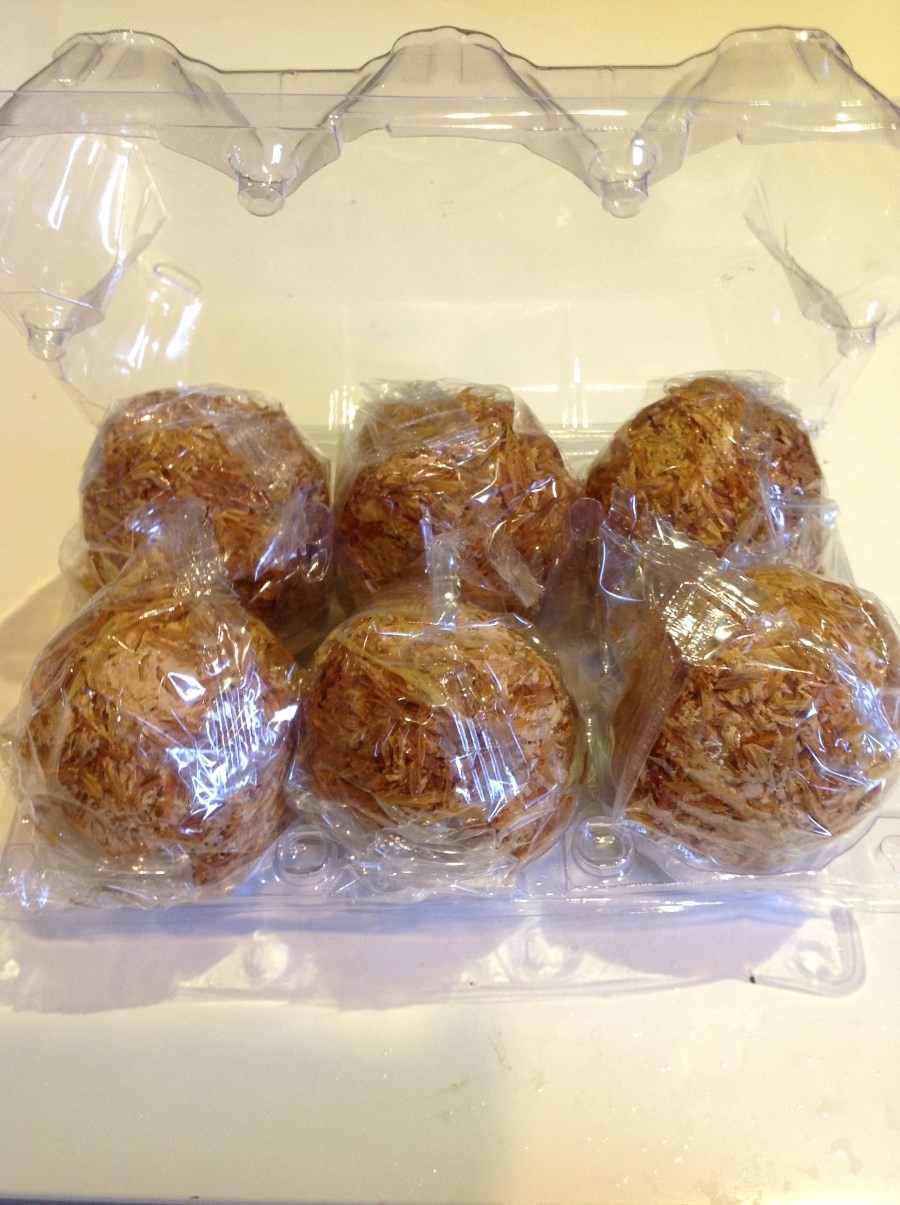
Photo 18.

source http://masterok.livejournal.com/3828228.html


